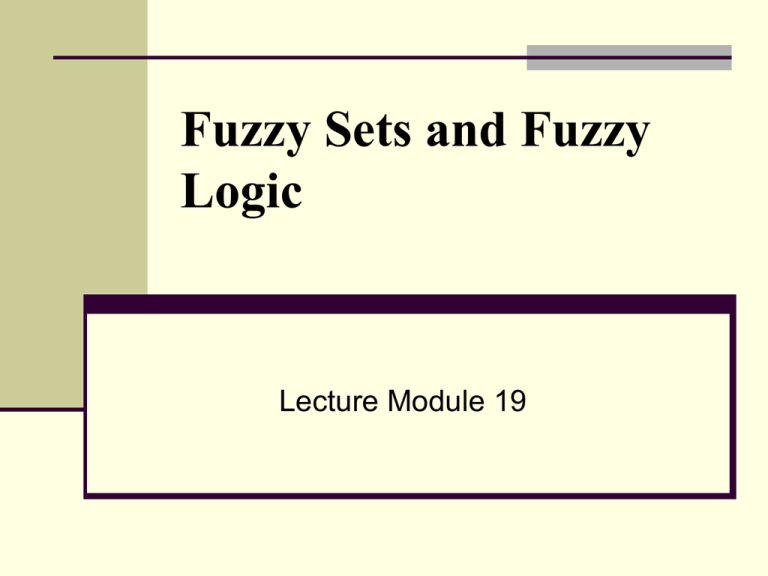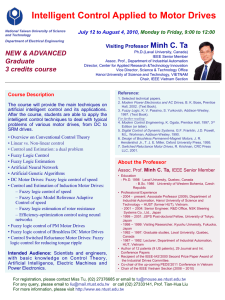Trapezoidal Membership Function
advertisement

Fuzzy Sets and Fuzzy
Logic
Lecture Module 19
Fuzzy Set
● Zadeh developed the concept of ‘fuzzy sets’ in mid 60’s
to account for numerous concepts used in human
reasoning which are vague and imprecise e.g. tall, old
● Fuzzy set is very convenient method for representing
some form of uncertainty.
● Later Zadeh developed ‘fuzzy logic’ to account for the
imprecision of natural language quantities e.g. (many)
and statements (e.g. not very likely).
● In Fuzzy logic, a statement can be both true or false
and also can be neither true nor false. Fuzzy logic is
non monotonic logic.
● Law of excluded middle does not hold true in fuzzy
logic.
− A V ~A = True ; A ~A = False -- do not hold
Cont…
● Well known paradoxes can not be solved using
classical logic.
● Russell’s paradox
− “All of the men in this town either shaved themselves or were
shaved by the barber. And the barber only shaved the men
who did not shave themselves“
− Answer to question: “ Who shaves the barber ? ” is
contradictory
− Assume that he did shave himself. But we see from the
story that he shaved only those men who did not shave
themselves. Therefore, he did not shave himself.
− But we notice that every man either shaved himself or was
shaved by the barber. So he did shave himself. We have a
contradiction.
Example - Paradox
● “ All Cretans are liars”, said the Cretan
● If the Cretan is liar then his claim can not be believed
and so is not a liar.
● If he is not liar then he is telling truth. But because he
is Cretan, he must therefore a liar.
● The main idea behind Fuzzy systems is that truth
values (in fuzzy logic) or membership values are
indicated by a value in the range [0,1] with 0 for
absolute falsity and 1 for absolute truth.
● Fuzzy sets are often incorrectly assumed to indicate
some form of probability.
● Even though they can take on similar values, it is
important to realize that membership grades are not
probabilities.
Cont…
● Probabilities on a finite universal set must add to 1
while there is no such requirement for membership
grades.
● Fuzzy set theory differs from conventional set theory
as it allows each element of a given set to belong to
that set to some degree.
● In contrast to classical set theory each element either
fully belongs to the set or is completely excluded from
the set.
● In other words, classical set theory represents a
special case of the more general fuzzy set theory.
● Elements in a fuzzy set X posses membership values
between 0 and 1.The degree to which an element
belongs to given set is called Grade of Membership.
Example
● Represent “Helen is old” using probability theory and
fuzzy set. Assume that Helen’s age is 75.
Probability approach:
● We may assign the statement “Helen is old” the truth
value of 0.95. The interpretation is that there is 95%
chance of Helen is old
Fuzzy approach:
● The statement could be translated into fuzzy set
terminology as follows:
● Helen is a member of the set of old people.
● It could be expressed in symbolic notation of fuzzy
set as OLD(Helen) = 0.95 i.e., Helen’s degree of
membership within the set of old people = 0.95
Distinction in two views
Important distinction between fuzzy systems and
probability.
● Although these two statements seem similar but they
actually carry different meanings.
● First view: There are 5% chances that Helen may
not old
● Second view: There is no chance of Helen being
young and she is more or less old.
− Here µOLD is a membership function operation on the fuzzy
set of old people (denoted OLD) which return a value
between 0 and 1.
Membership function µOLD for the fuzzy set OLD is
represented as
• Membership function for crisp (conventional) set
older than 50 years is represented as:
S-Function
● Function for Analytical approximation of a fuzzy
membership function is called S – function and is
defined as:
S(x, a, b, c) =
0,
for x a
2[(x-a) / (c-a)]2
for a x b
1- 2[(x-c) / (c-a)]2
for b < x c
1
for x c
− where a, b, c are the parameters of the curve and b is mid
point.
Cont…
● S-shaped function can be used to represent the
membership of different persons to fuzzy sets OLD,
TALL, RICH, STRONG etc.
● Definition: If X (Universal set) is a collection (set) of
objects denoted by x, then a fuzzy set F in X is a set
of ordered pairs
F = { (x, µF(x) ) | x X}
− where µF(x) is the membership function of x in F which
maps x to the membership space [0,1].
● Grade of membership 1 is assigned to those objects
that fully and completely belong to F and 0 to those
who do not belong to F at all.
Various Fuzzy Set Operations
Definition: (Intersection) The membership function µC(x) of
the set C = A B is defined as µC(x) = min {µA(x), µB(x)}, x
X.
Definition: (Union) The membership function µC(x) of C = A
B is defined as µC(x) = max{µA(x) , µB(x) }, x X.
Definition: (Complement) Membership function of the
complement of a fuzzy set A, µA’(x) is defined as µA’(x) =
[1 - µA(x) ], x X.
Example:
Let
X = { 1,2,3,4,5,6,7}
A = { (3, 0.7), (5, 1), (6, 0.8) } and B = {(3, 0.9), (4, 1), (6, 0.6) }
AB
= { (3, 0.7), (6, 0.6) }
A B
= { (3, 0.9), (4, 1), (5, 1), (6, 0.8) }
A’
= { (1, 1), (2, 1), (3, 0.3), (4, 1), (6, 0.2), (7, 1) }
Additional operations
Equality: A = B, if µA(x) = µB(x), x X
Not equal: A B, if µA(x) µB(x) for at least one x X
Containment: A B if and only if µA(x) µB(x), x X
Proper subset: If A B and A B
Product: A.B is defined as µA.B(x) = µA(x) . µB(x)
Power : AN is defined as: µAN(x) = (µA(x))N
Bold union : A B is defined as:
µA B(x) = Min [1, µA(X) + µB(x)]
8. Bold intersection: A B is defined as:
µA B(x) = Max [0, µA(x) + µB(x) - 1]
1.
2.
3.
4.
5.
6.
7.
Various Types of Membership Functions
• S-shaped function
• Z-shaped function
• Triangular Membership Function
• Trapezoidal Membership Function
• Gaussian Distribution Function
• Pi function
• Vicinity function
Various Types of Membership
Functions
●
●
●
●
●
●
●
S-shaped function
Z-shaped function
Triangular Membership Function
Trapezoidal Membership Function
Gaussian Distribution Function
Pi function
Vicinity function
S-shaped function
for x a
0,
for a x b
2
2[(x-a) / (c-a)] ,
S(x, a, b, c) =
1- 2[(x-c) / (c-a)] ,
for b < x c
1,
for x c
2
Graphical Representation of S-Shaped
Function
a
b
c
Figure S-shaped Membership Function
Z-Shaped Function
● It represents an asymmetrical polynomial curve open
to the left.
● Z-membership function may be defined as follows:
for x a
1,
2
1- 2[(x-a) / (c-a)] ,
Z(x, a, b, c) =
for a x b
2[(x-c) / (c-a)] ,
for b < x c
0,
for x c
2
Graphical Representation
a
b
c
Figure Z membership function
Triangular membership functions
F(x, a, b, c) =
0,
(x – a) / (b- a),
if x < a
if a ≤ x ≤ b
(c – x) / (c – b),
0,
if b ≤ x ≤ c
if c < x
Cont…
1.2
Membership Values
1
0.8
0.6
0.4
0.2
a
b
c
0
0
20
40
60
Figure Triangular Function
80
100
• Trapezoidal membership function
F(x, a, b, c, d) =
0,
(x – a) / (b- a),
1,
(d – x) / (d – c),
0,
if x < a
if a ≤ x ≤ b
if b < x < c
if c ≤ x ≤ d
if d < x
Trapezoidal membership function
F(x, a, b, c, d) =
0,
(x – a) / (b- a),
1,
(d – x) / (d – c),
0,
if x < a
if a ≤ x ≤ b
if b < x < c
if c ≤ x ≤ d
if d < x
Cont…
Gaussian membership function
( x b ) 2
( x, a, b) e
2a2
The graph given in Fig. 10.6 is for parameters a = 0.22, b = 0.78
a
b
Figure Gaussian Membership Function
Pi Function
● Pi-shaped curve is a spline-based curve which is named so because of
its shape.
● This membership function is evaluated at four points namely a, b, c, and
d.
● The parameters a and d locate the ‘feet’ of the curve, while b and c
locate its ‘shoulders’. In the graph given in Fig. 10.14, a = 2, b = 4, c = 5,
and d = 9.
a
b
c
d
Figure Pi-shaped Membership Function
Vicinity function
● To represent the statement “x is close to x0, where x0 is any
fixed value of x”, vicinity function using S function as follows
can be used:
S(x, a – b, x – b/2, a ),
for x a
1 - S(x, a, x + b/2, a + b),
for x a
V(x, b, a ) =
● This is also called π function. Here ‘b’ is called bandwidth.
● Total width of the function between two zero points is equal to
‘2b’.
a
Figure Vicinity Function
Basic Operations
● For reshaping the memebership functions, following
three operations can be used.
− Dilation (DIL) : It increases the degree of membership of all
members by spreading out the curve. For example,
DIL(OLD) = more or less OLD. Its membership function is
defined as: (µA (x)) 0.5
− Concentration (CON): It decreases the degree of
membership of all members. For example CONS(OLD) =
very OLD. Its membership function is defined as: (µA (x)) 2
− Normalization (NORM) : It discriminates all membership
degree in the same order unless maximum value of any
member is 1. Its membership function is defined as: µA(x) /
max (µA(x)), x X
− A fuzzy set is called normalized when at least one of its
elements attains the maximum possible membership grade
i.e., 1.
Methods for Determining Membership
Functions
● Membership functions can be designed by analyzing
the problem in hand.
● There are many possible forms of membership
functions.
● Most of the actual fuzzy control operations are drawn
from a small set of different curves.
● The methods for determining membership functions
may be broadly classified into the following categories
which are explained briefly as follows:
−
−
−
−
Subjective evaluation and elicitation
Converted frequencies or probabilities
Physical measurement
Learning and adaptation
Cont..
● Subjective evaluation and elicitation:
− Since fuzzy sets are usually intended to model people's
cognitive states, they can be determined from certain
elicitation procedures.
− Typically, these procedures are provided by the experts in
the problem area.
− For this purpose, a more constrained set of possible curves
are given from which an appropriate one can be chosen.
− Users can be tested using psychological tests for more
complex methods.
Cont...
● Converted frequencies or probabilities:
− It may be possible to use information taken in the form of
frequency histograms or other probability curves as the basis
to construct a membership function.
− There are a number of possible conversion methods, each
with its own mathematical and methodological strengths and
weaknesses.
− However, it should always be remembered that membership
functions are NOT (necessarily) equivalent to probabilities.
Cont...
● Physical measurement:
− Although many applications of fuzzy logic use physical
measurement, almost none of them measure the
membership grade directly.
− Instead, a membership function is obtained from another
method, and it is then used to calculate individual
membership grades of data.
● Learning and adaptation:
− Membership functions of fuzzy sets can be learned and
adapted from a given set to functions to suit the application.







